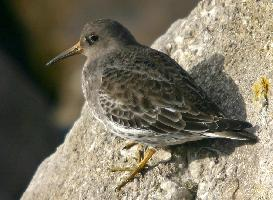
Állatleírás
The Terek sandpiper (Xenus cinereus) is a distinctive and fascinating wader, belonging to the family Scolopacidae, which includes other shorebirds such as sandpipers, snipes, and their kin. This species exhibits several unique features and behaviors that make it stand out among its peers in the avian world.Physically, the Terek sandpiper is a small to medium-sized bird, with adults typically reaching lengths of about 22-25 cm (8.7-9.8 inches) and weighing around 50-100 grams (1.8-3.5 ounces). One of its most distinguishing characteristics is its long, upturned bill, which curves upwards towards the tip, resembling a miniature avocet beak. This specialized bill is not just for show; it plays a crucial role in the bird's feeding strategy, allowing it to probe into the sand and mud for invertebrates in a way that differentiates it from other sandpipers.
The plumage of the Terek sandpiper is primarily greyish-brown on the upper parts and white on the underparts, with some individuals displaying a faint, diffuse breast band. During the breeding season, the plumage may take on a slightly rufous tone, especially around the head and breast, adding a subtle but noticeable vibrancy to their appearance. The legs are relatively long and bright yellow, a feature that is particularly striking and aids in identification, especially when observed foraging along shorelines.
Terek sandpipers are migratory birds, breeding in the taiga and forest-tundra zones of northern Russia and Siberia, and wintering in a broad range across coastal regions in East Africa, South Asia, Australia, and New Zealand. Their migration is a testament to their hardiness and adaptability, traversing thousands of kilometers across continents and oceans.
In terms of behavior, the Terek sandpiper is a dynamic and active forager, often seen running along beaches and mudflats, chasing after prey items such as insects, crustaceans, and small mollusks. Its upturned bill allows it to access food items buried in the substrate that might be inaccessible to other shorebirds with straight or downward-curving bills. This bird is also known for its distinctive flight pattern, characterized by rapid wingbeats and occasional glides, making it an agile and adept flyer.
The Terek sandpiper's vocalizations are another interesting aspect of its behavior. During the breeding season, males perform a unique, trilling display call, which is used to attract mates and establish territories. These vocal displays, coupled with aerial maneuvers, add a layer of complexity to their breeding rituals.
Conservation-wise, the Terek sandpiper is currently listed as Least Concern by the International Union for Conservation of Nature (IUCN), indicating that, for now, it does not face any immediate threats of extinction. However, like many migratory shorebirds, it is susceptible to habitat loss and degradation, especially in its wintering grounds and migratory stopover points. Preservation of wetland habitats is crucial for maintaining healthy populations of this and other similar species.
In summary, the Terek sandpiper is a remarkable bird, not only for its distinctive physical characteristics and intriguing behaviors but also for its epic migratory journeys. Its presence enriches the biodiversity of the wetlands and shorelines, making it a species of interest not only for ornithologists but for anyone fascinated by the natural world's wonders.
Hasonló állatok
Új állatfotók
Top 10 állat
- Dolphin gull (Leucophaeus scoresbii)
- Diana monkey (Cercopithecus diana)
- Moustached guenon (Cercopithecus cephus)
- Galápagos tortoise (Geochelone nigra complex)
- Japanese macaque (Macaca fuscata)
- Stone loach (Barbatula barbatula)
- Russian tortoise (Testudo horsfieldii)
- Greek tortoise (Testudo graeca)
- Common flying dragon (Draco volans)
- Vendace (Coregonus albula)


